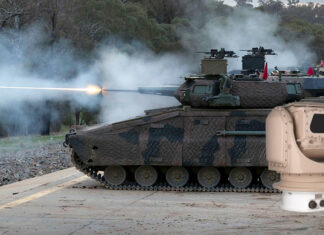With the US Navy pursuing its own SIGINT platform, the EP-X, the US Army is restarting its own Aerial Common Sensors (ACS) program, reflecting a fresh view at the mission requirements and capabilities of the platform. A final document is expected to be released by the end of this year with the selection of contractor later in 2009. Two years ago the Army terminated the previous ACS program realizing the RJ-145 platform selected by the prime contractor did not match the expanded mission requirement set by the Army. The revived program attracted much interest among industry, as 88 companies from 5 countries attended the briefing during an Industry Day hosted by the ACS program manager at Fort Monmouth in May 2008.
The new concept calls for a smaller crew and more automated mission systems. The future ACS will not be dedicated to the sensor processing role performed by previous systems, but more of a cooperative battlefield surveillance based on cooperative operation with other manned and unmanned systems. The ACS will accommodate four systems operators, to carry out battlefield electronic surveillance, including eavesdropping on communications intelligence (COMINT) and geolocation of targets based on their electronic signature (SIGINT). The Army is not defining the type of airframe for ACS – that will be decided by the system integrator. It is assumed that a turbo-prop or business jet types under-100,000-pound class will be considered.
According to Michael Madden, deputy project manager for ACS, the program office is expected to publish a draft request for proposal imminently (as of July 2008) following the approval of the Army Requirements Oversights Council. “One lesson we learned was that last time we said we were going to integrate existing sensors, but for various reasons ended up having to develop them as the sensors either did not become available or did not meet the requirement,” said Madden. “This time the requirements have been set in increments allowing us to specify qualified components and industry to select existing systems for integration.” One of the sensors destined to the ACS is the COMINT system to be supplied by Northrop Grumman. The company is currently supplying the equipment under the Guardrail upgrade program, part of a $460 million modernization of 33 operational Guardrails. The system has based on systems already proven on the Air Forces’ U-2/TR-1 aircraft and on the Global Hawk UAV, in a scaled down version.
The new ACS is expected to become operational by 2016, replacing two types of aircraft currently operated by the army – the Airborne Reconnaissance-Low and the RC-12Guardrail common sensor aircraft. By then, ACS will become the manned element of the Army’s future manned/unmanned teaming and battle command, a network of airborne Reconnaissance Surveillance and Target Acquisition/Intelligence Surveillance Reconnaissance RSTA/ISR family-of-systems, operated exclusively by the Army, including the Sky Warrior Unmanned Aircraft Systems (UAS), fixed wing and rotary wing RSTA systems linking to the Distributed Common Ground System- Army (DCGS-A) system.



















